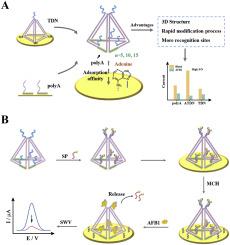Analytica Chimica Acta ( IF 5.7 ) Pub Date : 2023-10-25 , DOI: 10.1016/j.aca.2023.341947 Kaixuan Wang 1 , Nuanfei Zhu 1 , Yumo Li 1 , Hu Zhang 1 , Beibei Wu 2 , Jian Cui 3 , Jun Tang 2 , Zhugen Yang 4 , Fang Zhu 1 , Zhen Zhang 1

|
Tetrahedral DNA nanostructures (TDNs) are widely used in the development of electrochemical biosensors due to their structural stability, programmability, and strong interfacial orderliness. However, the complex modifications on the electrode and the single vertex target recognition of the TDNs limit their applications in electrochemical biosensing. Herein, we developed a universal detection system based on a novel polyadenine-based tetrahedral DNA nanostructure (ATDN) using Aflatoxin B1 (AFB1) as the model target for analysis. In the absence of target AFB1, the signal probes (SP) modified with ferrocene would be anchored by five aptamers on ATDN. The target capture by aptamers led to a release of SP from the electrode surface, resulting in a significant reduction of the electrochemical signal. This new nanostructure was not only dispensed with multi-step electrode modifications and strong mechanical rigidity but also had five modification sites which enhanced the detection sensitivity for the target. As a result, this biosensor shows good analytical performance in the linear range of 1 fg mL−1 to 1 ng mL−1, exhibiting a low detection limit of 0.33 fg mL−1. Satisfactory accuracy has also been demonstrated through good recoveries (95.2%–98.9%). The proposed new tetrahedral DNA nanostructure can provide a more rapid and sensitive alternative to previous electrochemical sensors based on the conventional TDN. Since DNA sequences can be designed flexibly, the sensing platform in this strategy can be extended to detect various targets in different fields.
中文翻译:

聚腺嘌呤介导的四面体 DNA 纳米结构,具有多个目标识别位点,用于黄曲霉毒素 B1 的超灵敏和快速电化学检测
四面体DNA纳米结构(TDN)由于其结构稳定性、可编程性和强界面有序性而被广泛用于电化学生物传感器的开发。然而,电极上的复杂修饰和 TDN 的单顶点目标识别限制了其在电化学生物传感中的应用。在此,我们开发了一种基于新型聚腺嘌呤四面体 DNA 纳米结构 (ATDN) 的通用检测系统,使用黄曲霉毒素 B1 (AFB1) 作为分析的模型目标。在没有目标 AFB1 的情况下,用二茂铁修饰的信号探针 (SP) 将通过 ATDN 上的五个适体锚定。适配体的目标捕获导致SP从电极表面释放,导致电化学信号显着减弱。这种新型纳米结构不仅无需多步电极修饰,机械刚性强,而且具有五个修饰位点,增强了对目标的检测灵敏度。结果,该生物传感器在1 fg mL -1至1 ng mL -1的线性范围内表现出良好的分析性能,表现出0.33 fg mL -1的低检测限。良好的回收率 (95.2%–98.9%) 也证明了令人满意的准确性。所提出的新型四面体 DNA 纳米结构可以为之前基于传统 TDN 的电化学传感器提供更快速、更灵敏的替代方案。由于DNA序列可以灵活设计,因此该策略中的传感平台可以扩展以检测不同领域的各种目标。

















































 京公网安备 11010802027423号
京公网安备 11010802027423号